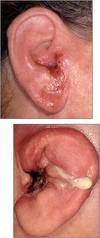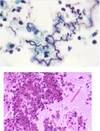Week 3 Flashcards
(85 cards)
Steps in reading X-Ray
Demopgrahics
Evaluate for adequacy RIIP
Evaluate heart and mediastinum
Evaluate lungs
Evaluate bones and soft tissues
Adequacy of Chest Radiograph
Rotation - spinous processes equidistant from clavicle ends (if spinous closer to right then rotated to left)
Inspiration - 9-10 posterior ribs seen on inspiration
Anatomy - 1st ribs, costophrenic angle and lateral edges
Penetration - see thoracic vertebral body underneath heart
Mistake of diagnosing if X-Ray
Underpenetrated - Pleural disease
Overpenetrated - underiagnosed pleural disease
What is left hear border is indistinct? Right?
Left lingular consolidation
Right middle lobe consolidation
Widened mediastinum (+8cm) causes
Thoracic aneurysm
Ruptured aorta
Aortic dissection
Mediastinal lymphadenopathy
What is the obliteration of silhouette sign diagnostic of?
pus, blood or fluid
Structures in contact with lungs on X-Ray

Otitis external
Another name?
Predisposing factors
Pathogens
Severe form
Treatment
Swimmer’s ear
Trauma (removing cerumen), High temp, Derm disease, insertion of foreign objects
Pseudomonas aeruginosa, Staphylococcus auerus
Malignant otitiss externa
Acetic acid-hydrocortisone eardrops; cirpo-hydrocortisone
Otitis externa presentation
Malignant otitis externa presentation
>38.3C, severe pain, purulent, otorrhea, necrosis can spread to mastoid, diabetes association, possibly fatal

Otitis media
Population
Most frequent diagnosis if febrile children
Who has reccurent otitis media
Who should be inspected for otitis media
Pathogen
In
Preceeded by
Treatment
Children
Otitis media
People with immune deficiencies
Children w/ purulent conjunctivitis or rhinosinusitis
Streptococcus pneumoniae, H. influenza (nontypeable), Moraxella catarrhalis (also S. aureus and S. pyogenes)
Gram negative bacilli
Viral infection
Amoxicillin

Otitis media presentation
Blocked eustachian tube, serous effusion, pain fever, tympahnic membrne bulge,
Hordeola
What is it?
Pathogen
Complication of
Treatment
What is Chalazia?
Acute purulent papules that occur at the lid margin
S aureus
blepharitis (blockage and infection of Zeiss or Moll sebaceous glands or Meibomian glands in the tarsal plate
Lancing (external), dicloxacillin (internal), good hygiene
granulomatous lesions that are not painful

Preseptal and orbital celulits
Infection of what
Preseptal cellulitis (PC) vs. Orbital cellulitis (OC)
Cause for orbital cellulitis
Complication
Pathogens
eyelid and periorbital soft tissues
OC much more serious
Ethmoid sinutitis
Cavernous venous thrombosis
S. pneumoniae, S. aureus

Conjunctivitis
Common name
What is it?
Other complication
Most common Pathogens
Purulen conjuctivitis
Hyperpurulent conjunctivitis
Follicular (inclusion) conjunctivitis
Disease caused by N. gonorrhoeae and C. trachomatis
Pink eye
Inflammation of palpebral and bulbar conjuctiva
Keratoconjunctivitis
Adenoviruses, HSV1/2 (less common but serious)
S. aureus; S. pneumonia; Moraxella; H. ifluenzae
Neisseria gonorrhoeae
Chlamydia trachomatis -> trachoma (blindness) -> conjuctival scarring & hypertrophy
Opthalamia neonatorum -> invasive -> rapid perforation
Viral conjunctivitis presentation
Injection (blood vessel dilatation)
Burning / Grit sensation of foreign body
Vision not impaired

Ophthalmia neonatorum presetnation
treatment
Karatoconjucitivtis -> progressing to perforation of cornea
Ceftriaxone

Trachoma presentation
Stages
End stage?
Treatment
Active trachoma, follicular response, trichiasis (Scarring)
Blindness
Azithromycin

What is the inflammation of cornea?
Cornea and conjuctiva?
Complication?
Risk factor?
Pathogens
keratitis
keratoconjunctivitis
vision-threatening
lenses
HSV12, S. aureus, fungi, Acanthamoeaba
HSV keratitis
treatment
trifluridine (often) and acyclovir
corticosteriods to prevent scarring

Uveitis
Causes
Pathogens
Inflammation of uvea – pigmented middle layer
Autoimmune, infections, trauma, idiopathic
Herpetic infections and toxoplasmosis

Uveitis types
pathogen/structure/description:
Anterior uveitis
Posterior uveiti
Panuveitis
Endopthalmitis
Anterior uveitis (iritis) == eye pain, desced vision, ciliary flush, cells in anterior == herpes simplex
Posterior uveiti (choroiditis/retinitis) == painless loss of vision, many cells in viterous == Toxoplasma gondi
Panuveitis (all) == Treponema pallidum
Endopthalmitis == fungal inf of viterous or aqueous humor or obth == Staph aureus, Strep, Gram(-)
Pathogenesis of common cold
Cause
Mecahnism
Progression
Rhinoviruses
Infect ciliated columnar epithelium cells
Host cells kiled inflammation
Can progress to paranasal sinusitits or otitis media or bronchitis
Acute rhinosinusitits
What is it
Cause
Pathogens
Complication
Pathogens of complication
Immuncomporomised pathogens
Inflammation or infection of nasal passage mucosa and at least one of the paranasal sinuses <4wks
Respiratory viruses (common cold, dentral etraction)
Rhinovirus, parainfluenza virus, adenovirus, respiratory syncytial virus
Acute bacterial rhinosinusitits
Strep pneu, Heam Inf, Moraxe catarrhalis
Mucor, Rhizopus, Asperigillus
Pharyngitis
Most common cause
Seriousness
Pathogens
Viruses ; S pyo (children)
Except diptheira it is mild
Rhinoviruses, adenoviruses, S. pyo, Cornybacterium, Candida






















